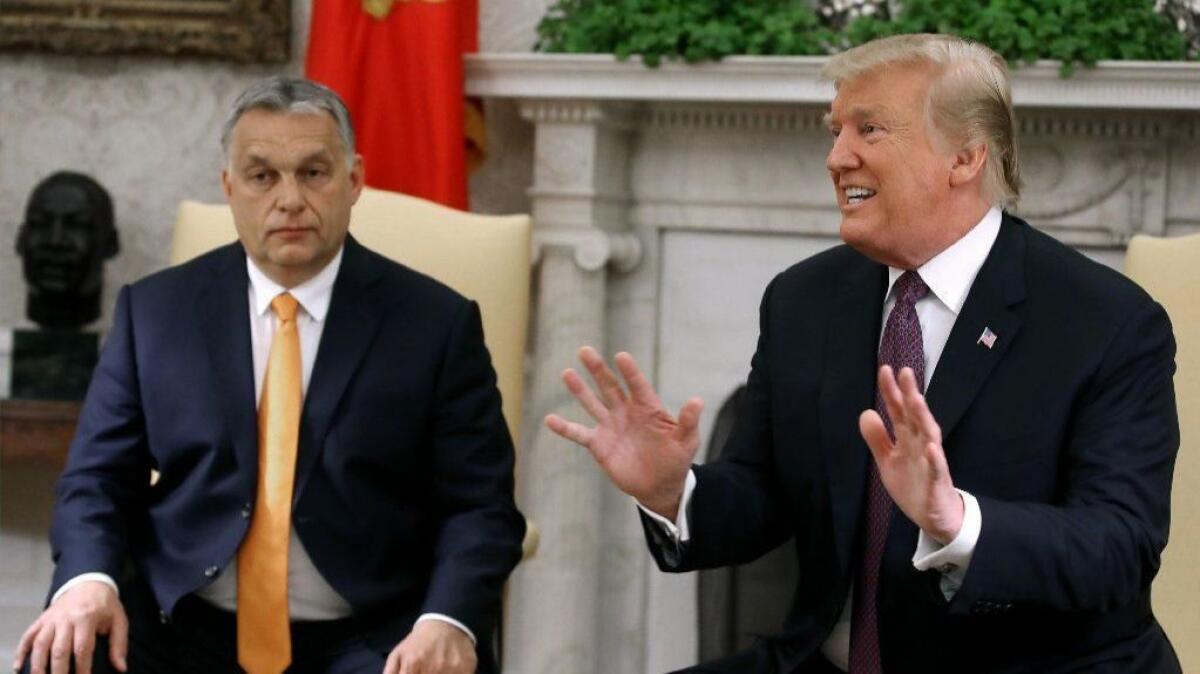Op-Ed: Democracies around the world are under threat. Ours is no exception

- Share via
“That men do not learn very much from the lessons of history,” Aldous Huxley wrote, “is the most important of all the lessons that history has to teach.”
He might well have been talking about the sunny predictions that liberal democracy was on the march after the Berlin Wall fell in 1989, and would inevitably triumph — or, as Francis Fukuyama famously asserted, that history was at an end, that human nature had changed.
Instead, history has returned with a vengeance. A 2020 Freedom House report found that, for the 14th year in a row, civil liberties and political freedoms had declined across the globe. This slide was reflected in the brutality of autocratic regimes like China, a rollback of democratic freedoms in countries like Hungary and Turkey, and eroding guardrails in two of the world’s largest democracies, India and the United States.
What’s made a growing number of democracies vulnerable to sabotage from within? How have aspiring strongmen been able to hijack so many governments?
Some lessons can be found in history, in books like Hannah Arendt’s great 1951 classic “The Origins of Totalitarianism,” which examined the social, economic and political conditions that fueled the rise of Nazism and Stalinism.
An outpouring of more recent books explore the relationship between democracy and autocracy — and the tectonic changes that have put cracks in the post-World War II order that lasted for more than 70 years. Among the most incisive of these books are: Richard Haass’ “A World in Disarray,” Edward Luce’s “The Retreat of Western Liberalism,” Timothy Snyder’s “On Tyranny,” “How Democracies Die” by Steven Levitsky and Daniel Ziblatt, Jason Stanley’s “How Fascism Works,” Yascha Mounk’s “The People vs. Democracy,” Masha Gessen’s “Surviving Autocracy,” Anne Applebaum’s “Twilight of Democracy,” Balint Magyar’s “Post-Communist Mafia State” and Ruth Ben-Ghiat’s forthcoming “Strongmen: Mussolini to the Present.”
Many of these works look at alarming developments in countries like Russia, Hungary, Turkey, Poland and Brazil — countries where the undermining of democracy has moved at headlong speed. Such countries serve as a warning — the Ghost of Christmas Yet to Come, as it were — to other nations like the United States, which remain democracies but are being steered by leaders like President Trump down a dark path toward autocracy. When read together, works of history about the monstrous dictatorial regimes of the 20th century and new books about today’s assaults on democracy provide a remarkably consistent picture of the playbook would-be despots use.
::
Few democracies these days are killed by coups. They die when aspiring autocrats get elected and subvert democracy from inside. The recipes they use are time-tested ones involving similar ingredients in varying combinations: sabotaging or rewriting constitutions in order to gut checks and balances on executive power; sidelining legislative bodies while claiming to be “the voice of the people”; packing courts and government agencies with loyalists while purging experts and civil servants; delegitimizing political opponents and electoral processes; attacking or censoring the free press; tolerating or encouraging violence on the part of supporters; threatening to take legal action against political rivals.
And it’s not just the manipulation of government levers that follows a pattern. In a 1995 essay, writer and philosopher Umberto Eco drew upon his childhood memories of growing up in Mussolini’s Italy to construct an anatomy of what he called “Ur-Fascism,” a variety of despotism, he warned, that “is still around us, sometimes in plainclothes.”
Among its features are: the fueling of us-versus-them dynamics, playing upon a “fear of difference”; the invocation of a nostalgia for a mythic past; a sense of beleaguerment manifesting itself in paranoia; and emotional appeals to aggrieved members of a middle class.
Jason Stanley, a Yale philosophy professor and the author of “How Fascism Works,” contends this is why “fascism flourishes in moments of great anxiety.” The narrative is put forward “that a once-great society has been destroyed by liberalism or feminism or cultural Marxism or whatever, and you make the dominant group feel angry and resentful about the loss of their status and power.”
::
Such conditions, historians remind us, existed during the 1930s, as countries struggled with the fallout of the Great Depression and the aftermath of World War I. In a rapidly changing world, Arendt observed, “atomized, isolated individuals” are susceptible to extreme movements, which offer them a sense of belonging and empowerment.
Today’s political landscape has been similarly shaped by the financial crisis of 2008, which fueled already troubling dynamics like growing income inequalities and stagnating social mobility, even as it heightened worries about globalization, technology, unemployment and immigration. These dynamics fed a mistrust of elites and helped open the door to right-wing populist leaders who peddled nationalism and nativism, and cast ethnic minorities and migrants as scapegoats.
Once in power, many would-be autocrats maintain the rituals of democracy — like multiparty elections — but these increasingly become a charade. Earlier this year, Russians voted (overwhelmingly, it was said) to approve constitutional amendments that would allow Vladimir Putin to stay in office until 2036, but the outcome was never in question: Bookstores were selling copies of the new constitution days before the vote’s outcome was announced.
Former senior intelligence officer Andrea Kendall-Taylor testified before Congress that “personalist dictatorships” have become increasingly common since the end of the Cold War. It’s a form of government, she argued, that tends to produce “risky and aggressive foreign policies” and volatile decision-making. Strongman autocracies, she added, frequently “depend on the distribution of financial incentives to maintain power.”
::
Putin’s Russia has served, in many respects, as an autocratic model for Erdogan’s Turkey and Orban’s Hungary. And Orban’s Hungary, in turn, has served as a model for Poland and, potentially, other states in Eastern and Central Europe.
Since winning a majority in Poland in 2015, the right-wing, populist Law and Justice party has aggressively asserted control over the courts, undermining the checks and balances provided by an independent judiciary. This February, the AP reported, Poland’s President Andrzej Duda signed into law much-criticized legislation giving politicians the power to fine and fire judges whose decisions they consider harmful.
In Turkey, President Recep Tayyip Erdogan has amassed sweeping executive powers that vastly expanded his authority over parliament and the courts, and gave him the ability to appoint a host of top officials with little oversight.
Erdogan — who long complained about a “deep state” — had more than 130,000 civil servants fired or suspended after a failed coup in 2016. More than 80,000 citizens were arrested or imprisoned, and tens of thousands were investigated for insulting the president, which can carry a prison term of up to four years. Meanwhile, Erdogan has run the Turkish economy like a patronage network, enriching allies and cronies.
In Hungary, Prime Minister Viktor Orban has pushed through more than 1,000 laws hollowing out the independence of the judiciary. At the same time, he has accelerated the culture wars. During Europe’s refugee crisis, he had a fence built on Hungary’s southern border and railed against “Muslim invaders.” Promising to “make Hungary great again,” he hailed “the role of Christianity in preserving nationhood.” The Hungarian sociologist Balint Magyar and other observers have suggested that such populist appeals are motivated less by ideology than by a strategy on the part of Orban and his party to appear to stand for something while they are busy shoveling state resources into private bank accounts.
::
In many countries sliding toward autocracy, governments have cracked down on the free press while encouraging friendly media outlets to spread propaganda and attacks on opponents. The Hungarian government, for instance, has concentrated control of much of the media in the hands of Orban allies; many of those outlets, which enjoy substantial state advertising contracts, now promote conspiracy theories and anti-EU propaganda.
Meanwhile, in Turkey, Erdogan’s government has closed more than 100 news outlets and jailed dozens of journalists since the attempted 2016 coup. In the Philippines, President Rodrigo Duterte has denounced journalists as “spies” and “fake news.” And in Brazil, President Jair Bolsonaro has accused journalists of “malevolence” and “debauchery.”
Not only has social media amplified political divisions and polarization, it has been weaponized by regimes like Putin’s in Russia to sow division. Outrage gives way to outrage fatigue, which gives way to the sort of cynicism that makes people give up on the political process, which, in turn, helps a dictator retain power.
::
If a democracy can be undermined by a would-be autocrat, can the process be reversed? Can elections or mass protests end a power grab and restore democratic institutions? A recent study from Sweden’s V-Dem Institute offers this grim statistic about the post-Cold War era: 60 of the 75 democracies that “underwent autocratization turned into autocracies.”
Much depends, of course, on how polarized a country already is, how resilient its institutions are, and whether the would-be tyrant is able to co-opt enough high-ranking officials to cripple constitutional checks on executive power.
At the same time, autocratic leaders try to tilt the playing field to ensure their ability to stay in office, using tactics like voter suppression, voter intimidation, gerrymandering and the sowing of division among opponents.
The longer autocratic leaders stay in power, the more lasting damage they do to a country’s institutions and people’s trust in the government. What’s more, the scholar Yascha Mounk argues, autocratic populists who win reelection “nearly always become more radical and more dangerous.” During Narendra Modi’s first term as prime minister of India, there was an explosion of hate crimes against Muslims and a clampdown on critics of his Hindu nationalist agenda. But after Modi won reelection in 2019, Mounk observes, things got even worse. Modi doubled down on his nationalist message, inflaming religious and cultural tensions, and launched an assault on the very idea of India as the secular and inclusive nation its founders envisioned.
Attacks on democracy around the world have a snowballing effect, with one autocrat learning techniques from another. Under Trump, the United States no longer provides a model of democracy to emulate; rather, Trump has openly expressed admiration for strongmen like Erdogan, Orban and Kim Jong Un. Meanwhile, Putin’s Russia has worked to undermine liberal democracies in the West, and Xi Jinping’s China has used its growing economic clout to fill the vacuum left by America’s retreat from the world stage.
None of this is good news for democracy. But in places like Belarus, Hong Kong and Thailand, pro-democracy demonstrators have been bravely taking to the streets to protest.
In the past, America has demonstrated what Alexis de Tocqueville called an “ability to repair her faults” — and arguably could again if Trump is voted out of office Tuesday. Decades ago, Watergate led to reforms that tried to address issues like campaign finance, presidential war powers and government ethics. And the corruption and greed of the late 19th century gave way to the reforms of the Progressive era, including women’s suffrage, antitrust legislation and changes to electoral law.
Hopeful reminders, in the words of the authors of the V-Dem report, that just as “it was premature to announce the ‘end of history’” after the fall of the Berlin Wall, so “it is premature to proclaim the ‘end of democracy’ now.”
Michiko Kakutani, a Pulitzer Prize-winning literary critic, is the author of “Ex Libris: 100+ Books to Read and Re-Read.” @michikokakutani
More to Read
A cure for the common opinion
Get thought-provoking perspectives with our weekly newsletter.
You may occasionally receive promotional content from the Los Angeles Times.










